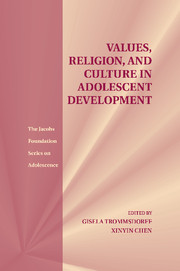Book contents
- Values, Religion, and Culture in Adolescent Development
- Series page
- Values, Religion, and Culture in Adolescent Development
- Copyright page
- Dedication
- Contents
- Contributors
- Preface
- Acknowledgments
- Part One Theoretical Perspectives on Values, Religion, and Adolescent Development in Cultural Context
- 1 Cultural Perspectives on Values and Religion in Adolescent Development
- 2 Psychological Functions of Religion in Youth – A Historical and Cultural Perspective
- 3 Cultural Differences in Self-Awareness in Adolescence Pathways to Spiritual Awareness
- Part Two Universal and Culture-specific Functions of Adolescent Values and Religion
- Part Three Impact of Values and Religion on Adolescent Adjustment in Times of Social Change
- Part Four Socialization Processes of Values and Religion in Adolescent Development
- Index
3 - Cultural Differences in Self-Awareness in Adolescence Pathways to Spiritual Awareness
from Part One - Theoretical Perspectives on Values, Religion, and Adolescent Development in Cultural Context
Published online by Cambridge University Press: 05 September 2012
- Values, Religion, and Culture in Adolescent Development
- Series page
- Values, Religion, and Culture in Adolescent Development
- Copyright page
- Dedication
- Contents
- Contributors
- Preface
- Acknowledgments
- Part One Theoretical Perspectives on Values, Religion, and Adolescent Development in Cultural Context
- 1 Cultural Perspectives on Values and Religion in Adolescent Development
- 2 Psychological Functions of Religion in Youth – A Historical and Cultural Perspective
- 3 Cultural Differences in Self-Awareness in Adolescence Pathways to Spiritual Awareness
- Part Two Universal and Culture-specific Functions of Adolescent Values and Religion
- Part Three Impact of Values and Religion on Adolescent Adjustment in Times of Social Change
- Part Four Socialization Processes of Values and Religion in Adolescent Development
- Index
Summary
Self-awareness increases dramatically for adolescents worldwide. We seek to understand how cultural differences in self-awareness may contribute to cultural differences in spiritual awareness among adolescents. The focus is on comparisons between European-Americans and East Asians. There is little research on cultural differences in self-awareness, despite substantial evidence of cultural differences in its key components: (1) the vantage point of awareness – whether it is a first person perspective, from the inside-out (European-Americans) or a third person perspective, from the outside-in (East Asians); (2) the conception of self and of standards – whether self is seen as relatively independent and standards are based on personal desires and ideals (European-Americans) or self is seen as interdependent and standards are based on social obligations and norms (East Asians); and (3) the nature of self-evaluation – whether it is focused on enhancing esteem (European-Americans) or maintaining face (East Asians). We suggest that self-awareness may activate mortality salience and thereby may elicit cultural worldviews. Cultural differences in self-awareness leads to different spiritualities that present different “worldview” defenses against the existential concerns engendered by the interaction of self-awareness and mortality salience. Salvation through prayer and through good deeds, and approval from a loving God, common in Christianity, alleviate European-Americans’ mortality concerns. By contrast, meditation, self change, and unity with the universe, common in Buddhism, alleviate East Asians’ mortality concerns.
- Type
- Chapter
- Information
- Values, Religion, and Culture in Adolescent Development , pp. 66 - 94Publisher: Cambridge University PressPrint publication year: 2012



